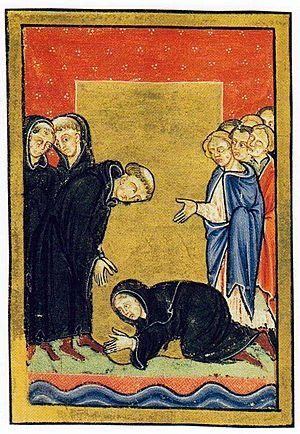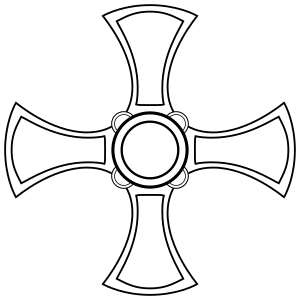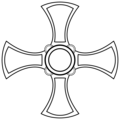Cuthbert facts for kids
Quick facts for kids SaintCuthbert |
|
|---|---|
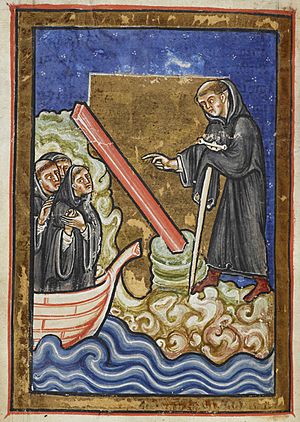
Cuthbert discovers a piece of timber, from a 12th-century manuscript of Bede's Life of St Cuthbert
|
|
| Bishop | |
| Born | c. 634 Dunbar, Northumbria (now in Scotland) |
| Died | 20 March 687 Inner Farne, Kingdom of Northumbria (now in England) |
| Venerated in | Catholic Church; Anglicanism; Eastern Orthodox Church |
| Major shrine | Durham Cathedral, England |
| Feast | 20 March, Catholic Church, Episcopal Church; 4 September (Catholic Ordinariates) |
| Attributes | Bishop holding a second crowned head in his hands; sometimes accompanied by seabirds and animals |
| Patronage | Kingdom of Northumbria |
Cuthbert of Lindisfarne (around 634 – 20 March 687) was an important Anglo-Saxon saint. He lived in the early church of Northumbria, following the Celtic tradition. Cuthbert was a monk, a bishop, and a hermit. He is linked to the monasteries of Melrose and Lindisfarne. These places are in what is now north-eastern England and south-eastern Scotland.
During his life and after his death, he became a very popular medieval saint in Northern England. Many people visited his tomb at Durham Cathedral. Cuthbert is seen as the patron saint of Northumbria. His feast days are 20 March (in the Catholic Church, Church of England, Eastern Orthodox Church, and Episcopal Church) and 4 September (in the Church in Wales and Catholic Church).
Cuthbert grew up near Old Melrose Abbey in Scotland. He decided to become a monk after seeing a vision in 651. This was the night Aidan, who founded Lindisfarne, died. Cuthbert became a guest-master at Ripon monastery around 655. Later, he became prior (a leader) at Melrose around 662. Around 665, he moved to Lindisfarne as prior. In 684, he was made bishop of Lindisfarne. However, he resigned in late 686 and returned to his quiet hermitage. He felt he was going to die soon. He was probably in his early 50s when he passed away.
Contents
The Life of Saint Cuthbert
Cuthbert's Early Years
Cuthbert was born around 634 in Dunbar, which was then part of Anglo-Saxon Northumbria. Today, Dunbar is in Scotland. His birth happened about ten years after King Edwin became Christian in 627. Christianity was slowly spreading across the kingdom.
The politics of the time were often violent. Sometimes, pagan rulers took power again. Spreading Christianity was a big job that lasted all of Cuthbert's life. King Edwin was baptized by Paulinus of York, a Roman missionary. But King Oswald, who came after Edwin, invited Irish monks from Iona. They founded the monastery at Lindisfarne, where Cuthbert would spend much of his life. This was around 635, when Cuthbert was born.
There was often tension between Roman and Celtic styles of Christianity. Wilfrid, a strong supporter of Roman ways, made this tension worse. Cuthbert was taught in the Celtic tradition. But he followed his teacher Eata in accepting the Roman ways. This happened after the Synod of Whitby in 664. Cuthbert seemed to accept these changes easily.
Early stories about Cuthbert focus on the many miracles he performed. He was a tireless traveling priest. He spread the Christian message to far-off villages. He was also good at impressing kings and nobles. Unlike Wilfrid, Cuthbert lived a very simple life. When he could, he lived as a hermit, but he still welcomed many visitors.
Where Did Cuthbert Come From?
In Cuthbert's time, the Anglo-Saxon Kingdom of Northumbria covered parts of northern England. It also included parts of south-eastern Scotland, sometimes reaching as far north as the Firth of Forth. Cuthbert might have been from near Dunbar, in modern-day Scotland. Some records say he was raised as a child near Melrose. Being fostered (raised by another family) could mean he was from a noble family. References to him riding a horse when young also suggest this.
One night, when he was a boy working as a shepherd, he had a vision. He saw the soul of Aidan being carried to heaven by angels. Later, he found out that Aidan had died that very night. Some historians think his work as a shepherd suggests he was from a humble family. He may have served in the military for a time. But at some point, he joined the new monastery at Melrose. He served under the prior, Boisil. When Boisil died in 661, Cuthbert became prior in his place.
Cuthbert's Important Roles
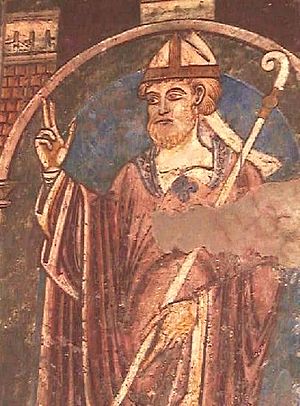
Cuthbert became known for his strong faith, hard work, and obedience. When Alchfrith, king of Deira, started a new monastery at Ripon, Cuthbert became its guest master. He worked under Eata. When Wilfrid became the abbot of Ripon, Eata and Cuthbert went back to Melrose.
In 664, an illness hit the monastery. Cuthbert recovered, but the prior died. Cuthbert was then made prior in his place. He spent a lot of time with people. He helped them with their spiritual needs. He went on missionary trips, preached, and performed miracles.
After the Synod of Whitby, Cuthbert accepted the Roman customs. His old abbot Eata asked him to bring these customs to Lindisfarne. Cuthbert became prior there. He was known for his simple lifestyle and his kindness to the poor. His reputation for healing and wisdom made many people seek his advice. He was even called the "Wonder Worker of Britain." He kept doing his missionary work. He traveled across the country, from Berwick to Galloway. He did pastoral work and founded a small church at Dull, Scotland. He also built a small cell for himself. It is also said that he founded St Cuthbert's Church in Edinburgh.
Life as a Hermit
Cuthbert decided to retire in 676. He wanted a quieter life of prayer and thought. With his abbot's permission, he moved to an island near Lindisfarne. Later, Cuthbert moved to Inner Farne island. This island is two miles from Bamburgh, off the coast of Northumberland. There, he lived a very strict and simple life.
At first, he received visitors. But later, he stayed in his small cell. He only opened his window to give his blessing. He could not refuse a meeting with the holy abbess Elfleda. She was the daughter of Oswiu of Northumbria. Elfleda became abbess of Whitby in 680. Their meeting took place on Coquet Island, further south off the Northumberland coast.
Becoming a Bishop and His Death
In 684, Cuthbert was chosen to be the Bishop of Hexham. This happened at a meeting at Twyford (thought to be modern-day Alnmouth). But he did not want to leave his quiet life to become a bishop. Only after a large group, including King Ecgfrith, visited him, did he agree. He became Bishop of Lindisfarne instead. Eata went to Hexham in his place.
Cuthbert was officially made bishop in York by Archbishop Theodore and six other bishops. This happened on 26 March 685. But after Christmas in 686, he went back to his cell on Inner Farne Island. He died there on 20 March 687, after a painful illness. He was buried at Lindisfarne that same day.
After many journeys to escape the Danes, his remains eventually settled in Durham. This led to the founding of the city and Durham Cathedral. The St Cuthbert Gospel is one of the important items found in St Cuthbert's coffin. The coffin itself is also a very important historical object.
Cuthbert's Lasting Impact
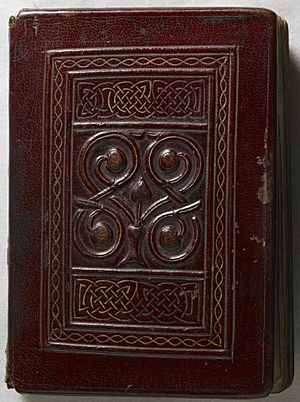
After Cuthbert's death, many miracles were said to happen through his help. People also prayed near his remains. Alfred the Great, King of Wessex, was especially inspired by Cuthbert. He had a vision or dream of Cuthbert. This encouraged him in his fight against the Danes. After this, the royal family of Wessex, who became the kings of England, showed great devotion to Cuthbert. This also helped unite the country.
Cuthbert was seen as "a figure of peace and a symbol for the new identity of Northumbria and England." This happened after the Danish people joined Anglo-Saxon society. The historian Bede, who lived in the 8th century, wrote two books about St Cuthbert around 720. Cuthbert has been called "perhaps the most popular saint in England" before Thomas Becket died in 1170.
In 698, Cuthbert was reburied at Lindisfarne. His decorated oak coffin is now known as St Cuthbert's coffin. He would have many more coffins over time. In 995, the "community of Cuthbert" settled in Durham. They believed the saint wanted to be there. This happened when the wagon carrying his coffin got stuck on the road. It was being moved back to Chester-le-Street after escaping a Danish invasion.
Cuthbert's Influence in Northumbria
During the Middle Ages, Cuthbert became very important for the identity of people in Northumbria. This was the area north of the River Tees. People called themselves the 'people of St Cuthbert'. This meant everyone between the River Tees and the River Tweed.
By the late 11th century, the Bishops of Durham created a special area. It was called the Liberty of Durham, and later the Palatinate of Durham. This area was between the Rivers Tyne and Tees. In this area, the Bishop of Durham had almost as much power as the king of England. The saint became a strong symbol of the region's independence. The people of the Palatinate were known as the haliwerfolc, meaning "people of the saint." Cuthbert gained a reputation for fiercely protecting his land.
For example, there is a story from the Battle of Neville's Cross in 1346. The Prior of Durham Abbey had a vision of Cuthbert. Cuthbert told him to take the saint's special cloth and raise it on a spear like a banner near the battlefield. When the Prior and his monks did this, they felt protected by St Cuthbert. Whether the vision is true or not, the banner of St Cuthbert was often carried in battles against the Scots. This continued until the Reformation. It shows how St Cuthbert was seen as a protector of his people. A new version of the Banner is now on display at his shrine in Durham Cathedral.
Cuthbert's popularity also spread to the converted Danes. They made up much of the population in the Kingdom of York. The Normans also adopted Cuthbert's cult when they took over England. Cuthbert's shrine at Durham Cathedral was a major pilgrimage site. People visited it throughout the Middle Ages. It was eventually stripped by King Henry VIII's officials during the Dissolution of the Monasteries.
Cuthbert's Relics

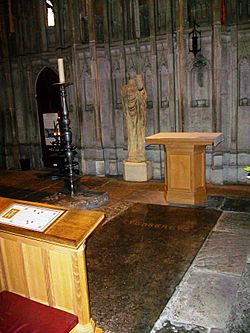
According to Bede's writings, Cuthbert's coffin was opened eleven years after his death. His body was found to be perfectly preserved, or incorrupt. This amazing event led to Cuthbert's growing fame after his death. He became the most popular saint in Northern England. Many miracles were said to happen through his help and prayers near his remains.
In 875, the Danes attacked the monastery of Lindisfarne. The monks fled, carrying St Cuthbert's body with them. They traveled to various places, including Melrose. After seven years of wandering, the body found a resting place at St Cuthbert's church in Chester-le-Street. This was until 995. Another Danish invasion led to its removal to Ripon. Then, it was believed the saint wished to stay in Durham. A new stone church, called the "White Church," was built. This was the church before the current grand Cathedral. In 999, his relics were placed in the new church on 4 September. This day is celebrated as the feast of his translation at Durham Cathedral.
In 1069, Bishop Æthelwine tried to move Cuthbert's body to Lindisfarne. He wanted to escape from King William at the start of the Harrying of the North.

In 1104, Cuthbert's tomb was opened again. His relics were moved to a new shrine behind the altar of the newly finished Cathedral. When the casket was opened, a small book was found. It was a copy of the Gospel of John, measuring about 138 by 92 millimeters. This book is now known as the Saint Cuthbert Gospel. It is the oldest Western book that still has its original bookbinding. The binding is made of finely decorated leather.
Much later, a set of vestments (special clothes) from 909–916 were also found. These were made of Byzantine silk and had a "Nature Goddess" pattern. They included a stole and decorations with very rare Anglo-Saxon embroidery. King Æthelstan (who ruled from 927–939) had placed these in Cuthbert's tomb. He did this during a pilgrimage when Cuthbert's shrine was at Chester-le-Street.
Cuthbert's shrine was destroyed during the Dissolution of the Monasteries. But, unusually, his relics survived. They are still buried at the site. They were also dug up in the 19th century. At that time, his wooden coffin and other relics were removed. St Cuthbert's coffin (one of several he had) was put back together by experts. It is a rare and important example of Anglo-Saxon wood carving. When the coffin was last checked on 17 May 1827, a gold cross was found. It was decorated with garnets and had a special splayed shape. This shape was later used as the symbol of St Cuthbert in the arms of Durham and Newcastle universities.
Places Named After Cuthbert
The flag of County Durham (since 2013) features the Cross of St Cuthbert. Its colors are blue and gold. The flag of Kirkcudbrightshire in Scotland (since 2016) also features this cross. The county's name comes from Cuthbert. The Cross of St Cuthbert is also the main symbol on the coat of arms of the University of Durham. This was granted in 1843. The cross is also on the arms of many of its colleges.
The University of Newcastle upon Tyne also has St Cuthbert's Cross on its arms. This was granted in 1937. The cross of St Cuthbert is also on the badges of two Anglican secondary schools in Tyne and Wear: Dame Allan's Schools and Sunderland High School.
St Cuthbert's Society, a college of Durham University, was started in 1888. It is named after him and is close to the saint's coffin at Durham Cathedral. The Society celebrates St Cuthbert's Day around 20 March with a special meal. "Cuth's Day" is the annual college day. It is celebrated in the spring with music, fun, and festivities. Cuddy's Corse is a walking route between Chester-Le-Street and Durham Cathedral. It marks the journey between two of the coffin's last resting places.
Worksop College, founded as St Cuthbert's in 1895, was the last of the Woodard Schools to open.
St Cuthbert is also the namesake of St Cuthbert's College in Epsom, New Zealand. St Cuthbert's Day on 21 March is a day of school celebration. The school's houses are named after important places in the saint's life: Dunblane (yellow), Elgin (green), Iona (purple), Kelso (blue), Lindisfarne (white), Melrose (red), York (orange), and Durham (pink).
St Cuthbert's High School, a Roman Catholic school in Newcastle upon Tyne, is named after the saint. St Cuthbert's Day is celebrated with Mass. The school prayers mention their patron saint. The school badge shows a bishop's crook, referring to Cuthbert's time as a bishop. It also has ducks, showing his love for animals.
St. Cuthbert's Co-operative Society (now Scotmid) opened its first shop in Edinburgh in 1859. It grew to be one of the largest co-ops in Scotland. Its dairy used horse-drawn delivery floats until 1985. Between 1944 and 1959, Sean Connery, who later played James Bond, worked there as a milkman.
The Roman Catholic Diocese of Hexham and Newcastle considers St Cuthbert its patron saint. Bishops in the diocese are always made bishop on 20 March, Cuthbert's feast day in the Catholic Church.
Many churches are named after Cuthbert. An Orthodox Community in Chesterfield, England, has chosen St Cuthbert as their patron.
Fossilized crinoid parts found on Lindisfarne were threaded into necklaces or rosaries. They became known as St. Cuthbert's beads.
In Northumberland, the eider duck is called the cuddy duck. When on the Farne Islands, Cuthbert made special rules to protect the ducks and other seabirds nesting there. They still breed in large numbers off the Northumberland coast.
In Cumbria, the area and small village of Holme St Cuthbert are named after him. So is the local church. It is a rural area with one larger village and many smaller hamlets.
St Cuthbert's Way is a long walking route. It is one of Scotland's Great Trails.
Cuthbert is remembered in the Church of England with a Lesser Festival on 20 March.
Images for kids
-
Cuthbert discovers a piece of timber, from a 12th-century manuscript of Bede's Life of St Cuthbert
-
12th century wall-painting of St Cuthbert in Durham Cathedral
-
Cuthbert meets Ælfflæd of Whitby on Coquet Island, Bede's Life of Cuthbert, 12th century
-
The front cover of the St Cuthbert Gospel of St John, recovered from his coffin; the original tooled red goatskin binding is the earliest surviving Western binding.
-
The incorrupt body of Cuthbert from Bede's Life of Cuthbert, 12th century
-
Location of St Cuthbert's tomb and reburial in Durham Cathedral; behind is a damaged statue of St Cuthbert, holding the head of the king St Oswald (whose head was reburied with Cuthbert)
-
The Journey, a modern sculpture showing the travels of the Lindisfarne community, by Fenwick Lawson. Shown here in the Millennium Square, Durham.
See also
 In Spanish: Cutberto de Lindisfarne para niños
In Spanish: Cutberto de Lindisfarne para niños
- Vita Sancti Cuthberti
- Historia de Sancto Cuthberto
- St Cuthbert's Well in Bellingham, Northumberland
- Ushaw College (St Cuthbert's College, Ushaw) in County Durham
- Legend about his burial


